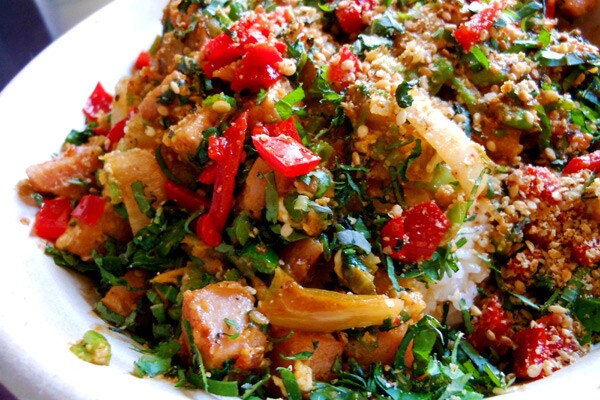Iconic Neighborhood Restaurants: Chinatown

Chinatown as we know it, anchored by the plazas, shops, and restaurants along Broadway and Hill Street, wasn't the city's first. Los Angeles's original Chinatown was located where Union Station now stands. It sprung up to house Chinese immigrants who had begun arriving in the early 1800s to build railroads and seek their fortunes. (The main drag, Calle de los Negros, would eventually become Los Angeles Street.) The neighborhood, which thrived with grocery stores, restaurants, herbalists, and curio shops, was home to almost 3,000 people. Most were men since laws often prevented them from bringing their families to the United States. In the 1930s, the residents of Old Chinatown were forced out to make room for the train station.

Two separate neighborhoods vied to take its place. China City, located across the street from Union Station, was a faux Chinese village conceived by the woman who had turned Olvera Street into a tourist destination. It catered to tourists with replicas of buildings from the hit 1937 movie The Good Earth. New Chinatown, in contrast, was funded and controlled by the Chinese American community. The two ventures opened in 1938, three weeks apart. Less than a year later, a large swath of China City burned down in a fire. A decade later, another fire sealed its fate. New Chinatown, meanwhile, hummed along. Nearly 80 years later, it supports Chinese American businesses as well as newer waves of entrepreneurs from Thailand, Vietnam, and greater Los Angeles.
Wing Hop Fung Ginseng & China Products: Located in the Far East Plaza, the two-story emporium is famous for its huge variety of loose-leaf teas. It also stocks all kinds of dried goods including mushrooms, sea cucumbers, ginseng, and traditional Chinese medicinal herbs. Upstairs you can peruse a cute and affordable selection of dishes, ceramic teapots, and other housewares. While you're browsing, load up on snacks, Japanese sake, and Korean fruit wines.
727 N. Broadway. 213-626-7200

Chego: Wherever Roy Choi goes, success seems to follow, whether its food trucks, restaurants, or hotels. Chego is a casual spot -- not much more than a counter, a few stools and several outdoor tables -- specializing in gloriously messy rice bowls that combine ingredients and cultures under an anything-that-tastes-awesome aesthetic. Your dish might include SPAM and kimchi fried in butter or pork belly with Chinese broccoli and cotija cheese. The Ooey Gooey fries, covered in a creamy-spicy sambal sauce and drowning in cheese, are worth the calories. Along with Portland transplant Pok Pok Phat Thai, gelateria Scoops and upstairs neighbor Ramen Champ, Chego is one of the newer establishments helping revitalize the sleepy Far East Plaza.
727 N. Broadway. 323-380-8680
General Lee's Bar: If you want a great selection of craft beer and an artsy dive bar, you go to Melody Lounge. If you want inventive cocktails, high ceilings and a laid back lounge, you come to General Lee's. It's remembered fondly by locals as the former Mountain Bar, but local history buffs know that this was one of the New Chinatown's first restaurants to open in 1938. Now DJs veer toward old school hip-hop and '90s jams while the friendly bartenders will help you decide between house specialities like a Green Tea Gimlet and a Yat Sen Old Fashioned, which puts an earthy, peppery twist on the classic cocktail.
475 Gin Ling Road, 213-625-7500

Phoenix Bakery: The oldest and largest bakery in Chinatown, Phoenix has been making "famous birthday cakes" (as its vintage sign proclaims) since 1938. The most famous of its creations is the strawberry cake with layers of fluffy vanilla cake, whipped cream and strawberries rolled in almond slivers. The array of pastries also includes eclairs, almond cookies, sticky honey butterflies, sesame balls filled with sweet red bean paste, baklava, danishes, cupcakes, and more. On the savory side, opt for a bun filled with barbecued pork, hot dogs or pepperoni.
969 N. Broadway. 213-628-4642
LAX-C: On Chinatown's industrial eastern edge, you'll find an odd strip mall that seems like it shouldn't quite be there. Most people come for the confusingly named LAX-C, a hangar-sized market that's basically the Thai Costco. Looking for industrially sized quantities of pickled chilies, fried shallots and tamarind paste? You're covered. For those who don't run a restaurant business, there's another draw: a food counter that serves tasty and remarkably cheap Thai food. For $7 to $9 you get a heaping scoop of rice and two or three dishes of your choice: stewed vegetables, stir fried meat dishes and several curries (the panang is worth the extra $1). It's all served on an orange cafeteria tray within smelling distance of the seafood counter. Afterward, don't leave the strip mall before visiting Chimney Coffee House. The coffee is strong and the brick toast -- thick wedges of sweet fluffy bread drizzled with honey and topped with ice cream and whipped cream -- is fantastic.
1100 N. Main St. 323-343-9000


